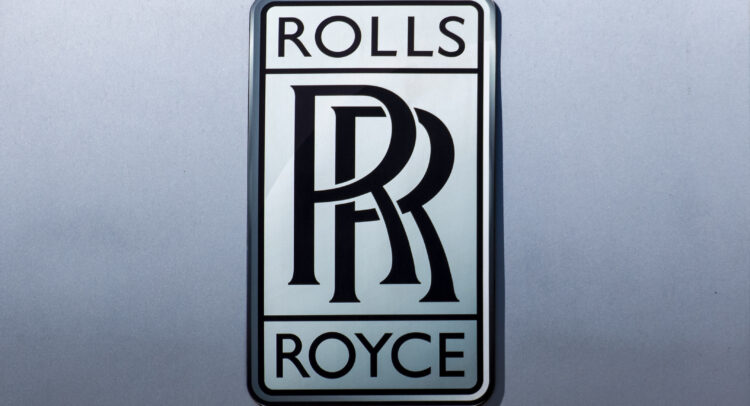Rolls-Royce (LSE:RR) shares were among the best-performing blue-chip stocks globally in 2023, delivering more than 200% growth during the year. Admittedly, Rolls was starting from a low bar. The British engineering giant endured a turbulent period during the pandemic, as the company, which derives much of its income from engine flying hours, experienced a significant downturn in revenue.
Rolls-Royce, which has nothing to do with the luxury car brand that was sold off decades ago, also suffered from the general negative sentiment surrounding UK stocks, especially during Liz Truss’s premiership. However, the turnaround has been dramatic, with Rolls continually beating analysts’ estimates over the past 12 months. Personally, I believe it can outperform again in 2024, noting attractive earnings metrics, strong tailwinds across the three main business segments, and a significant moat.

Competitive Advantage
Originally founded in 1904, Rolls-Royce has become synonymous with cutting-edge technology. Nowadays, the company’s culture of excellence is deeply ingrained, upheld by a commitment to innovation and precision engineering. Rolls-Royce’s engines, power systems, and defense technology are renowned for their reliability and performance, reflecting a dedication to pushing technological boundaries.
It’s this culture of excellence, combined with the regulatory environment of the industries in which it operates, that has helped create such a formidable moat. Stringent regulatory standards governing the aerospace, power systems, and defense industries act as high barriers to entry.
These are exceptionally hard industries to enter, with a complex web of compliance and considerable start-up costs. The fact that it may take the firm a decade to re-enter the narrow-body market is a testament to these exceptionally high barriers. Rolls’s moat is further broadened by long-standing partnerships with the government and OEMs. Collectively, this gives Rolls plenty of pricing power and a degree of strategic freedom to explore and invest in new projects.
The Turnaround Continues
In January 2023, Rolls-Royce’s newly appointed CEO, Tufan Erginbilgic, gave a stark assessment of the company’s standing, claiming, “We are on a burning platform.” His metaphor was meant to highlight the firm’s years of financial losses, dwindling capital, and underperformance in key markets.
Fast forward 15 months and Rolls-Royce has come along way. The company has become leaner and successfully implemented pricing increases, leading to margin expansion, while achieving volume growth across the entire business.
In turn, underlying earnings per share for 2023 came in at an impressive 13.8p. Interestingly, if we’d picked up Rolls-Royce shares at their bottom in late 2022, they’d have been trading at less than 5x forward earnings for 2023. At the current share price, Rolls is trading at 28x 2023 earnings.
While the current P/E ratio sounds expensive, the British firm is still expected to deliver sector-topping growth over the medium term. Basic earnings per share are forecasted to increase to 17.1p in 2025 and 20.1p in 2026. Correspondingly, the price-to-earnings ratio will fall to 22.5x in 2025 and then 19.1x in 2026.
Tailwinds and Headwinds
The most significant tailwinds, appropriately, are likely to come in the civil aviation sector. Rolls boasted a substantial engine order book — 1,405 engines as of the first half of 2023 – and that equates to over three years of deliveries at 2023 production rates. Clearly, the outlook is promising. In part, demand for new engines has been driven by the strength of the recovery in travel demand, as well as positive long-range forecasts.
In fact, Airbus (OTC:EADSF) predicts that the industry will need more than 40,000 new aircraft over the next two decades. Of these 40,850, some 32,630 will be single-aisle and 8,220 wide-body, according to the manufacturer. Amid a surge in the size of the global middle class and an accompanying boom in demand for leisure and business travel, the vast majority of aircraft demanded will be passenger carriers, with just 2,510 freighters.
Despite these promising figures, Rolls-Royce faces a challenge. The company predominantly manufactures large engines for wide-body aircraft and, therefore, lacks exposure in the next-generation single-aisle engine market. The British firm essentially left the narrow-body market in 2012 with the sale of its stake in the V2500 program to Pratt & Whitney.
Erginbilgic has suggested that the firm could re-enter the narrow-body market, indicating that its UltraFan architecture is adaptable to smaller-framed aircraft. Rolls says this next-gen power unit suits applications requiring thrust in the 25,000-110,000lb range. Despite this, and the research taking place at Rolls’s German subsidiary, Erginbilgic has suggested that it may be a decade before Rolls engines are running on narrow-body jets.
In addition to these plans to re-enter the narrow-body market, Rolls has strategically prioritized enhancing the efficiency of its existing portfolio of engines. The company is doing this by focusing on increasing time on wing (TOW), which is essentially a measurement of durability. Rolls is looking to boost TOW by 40% across its current portfolio.
Is Rolls-Royce a Buy, According to Analysts
With strong tailwinds in civil aviation and an impressive forecast for earnings growth, Rolls-Royce remains a Moderate Buy, according to Wall Street analysts. The stock currently has nine Buys, one Hold, and one Sell. The average RR stock price target is 412.21p, inferring 7.5% upside from the current share price.

Conclusion
I’m wary that companies don’t always achieve their growth expectations. However, the past 12 months have been incredibly encouraging, with multiple earnings beats. I think the future is bright for this British engineering firm, with tailwinds in all parts of its business. That’s why I’m still bullish on Rolls.
















